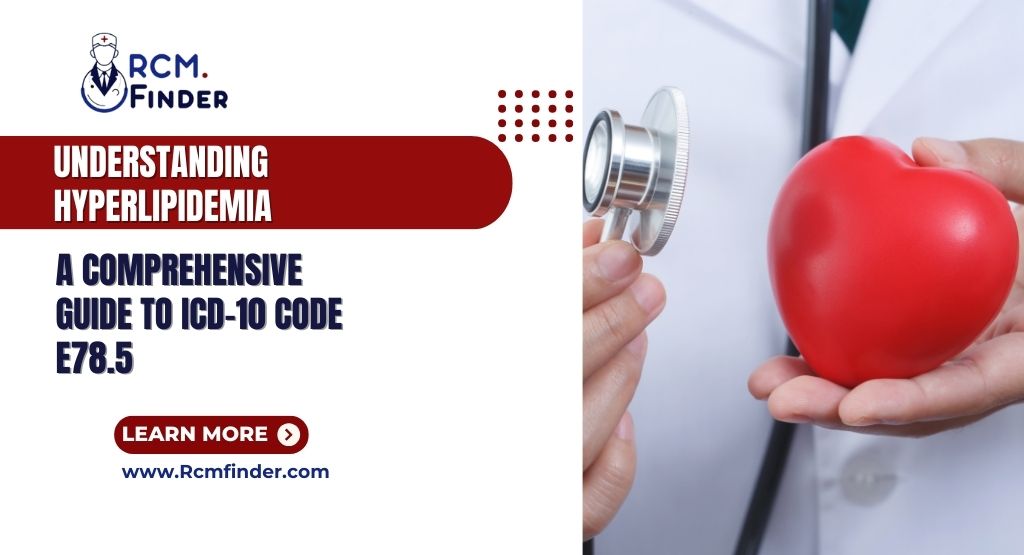
Understanding Hyperlipidemia ICD 10: A Comprehensive Guide
Table of Contents
Hyperlipidemia ICD 10, as represented with the number E78.5, is an important concept in the field of healthcare that deals with high levels of lipids in the blood. This article is designed to offer an in-depth analysis of the concept of hyperlipidemia and its definitions and the importance of the ICD 10 coding system. When you’ve finished this thorough guide, you’ll have an in-depth knowledge of hyperlipidemia and its consequences for healthcare as well as revenue cycle management.
What is hyperlipidemia?
Hyperlipidemia refers to the high concentrations of lipids, or fats, in bloodstreams. The condition could lead to serious health problems like cardiovascular disease when not properly managed. According to the American Heart Association, nearly 95 million people across the United States have high cholesterol. This hyperlipidemia code in ICD 10 plays an important role for healthcare providers and helps them to correctly update medical records according to the patient’s condition.
Types of Hyperlipidemia
Knowing the various types of hyperlipidemia is essential to managing the condition effectively. Here are the major types:
The Importance of ICD 10 Codes
Hyperlipidemia ICD 10 codes serve as a standard for healthcare professionals to provide information about patients’ conditions. This ICD 10 code for hyperlipidemia helps in an accurate billing and coding process crucial for the management of revenue (RCM). It makes sure that healthcare professionals get the proper compensation for the services they provide. It also aids in maintaining a thorough patient database.
Diagnosing Hyperlipidemia
A diagnosis of hyperlipidemia requires a number of blood tests to determine the levels of lipids, which include:
The total cholesterol is a measure of the overall health of cholesterol.
LDL Cholesterol A high level could lead to plaque accumulation in the arteries.
HDL Cholesterol: Also known by its designation as “good” cholesterol, higher levels of cholesterol are considered to be protective.
Triglycerides A rise in levels can be a sign of the possibility of cardiovascular disease.
These tests are essential in determining the correct ICD 10 number for hyperlipidemia as well as creating management strategies that are tailored to your needs.
Risk Factors for Hyperlipidemia
Many risk factors influence an increase in hyperlipidemia, which include
Diet: A diet that is high in trans fats and cholesterol can increase lipid levels.
Physical inactivity: A lifestyle that is sedentary increases the chance of developing abnormalities in lipids.
Obesity: Body weight that is too heavy is strongly linked to the levels of cholesterol and triglycerides.
Genetics: Hyperlipidemia in the family increases the risk of developing the condition.
Age: The risk of developing cancer is higher with age and is particularly high for people over 40.
Substantially Related Conditions: Diabetes and hypothyroidism can result in elevated lipid levels.
The Role of Lifestyle Modifications
The best way to manage hyperlipidemia requires lifestyle changes. Here are some suggestions:
Lifestyle Changes: Focus on a heart-healthy diet that is rich in vegetables, fruits, whole grains, and healthy fats. A Mediterranean diet is particularly healthy.
Regular physical exercise: Try to do at minimum 150 minutes of moderate-intensity aerobic workout each week to lower LDL cholesterol levels and increase HDL cholesterol.
The Management of Weight: The loss of even a little weight can have a major impact on the levels of lipids.
Beware of Tobacco Smoke: Quitting smoking cigarettes can help improve HDL cholesterol levels as well as the overall health of your heart.
Medications for Hyperlipidemia
In most cases, only making changes in the lifestyle is not enough to control hyperlipidemia. Here are some common medications:
Statins: They are the most often prescribed medicines to lower LDL cholesterol. Studies have proven that statins may lower the chance of heart attacks and strokes.
Fibrates: They are effective in reducing levels of triglycerides; fibrates could be prescribed along with statins for complete treatment.
Niacin: The vitamin may aid in increasing HDL cholesterol levels; however, it can cause negative side effects.
Bile Acid Sequestrants: These drugs assist in eliminating cholesterol from the bloodstream.
The Financial Impact of Hyperlipidemia
Hyperlipidemia can have significant financial consequences for healthcare providers . In the United States, the cost of treating cardiovascular diseases due to cholesterol levels is believed to exceed $200 billion per year. It includes medical direct expenses as well as indirect costs resulting from the loss of productivity.
The Importance of Regular Screening
Regular screening of lipid levels can be vital to detect and manage the early signs of hyperlipidemia. According to the American Heart Association, individuals who are 20 and over should have their cholesterol levels tested at least once every four to six years. Early intervention can dramatically lower the risk of heart disease and enhance long-term health outcomes.
Final Thoughts
In the end, understanding the ICD 10 for hyperlipidemia is crucial for both healthcare personnel and patients alike. This information will ensure a precise diagnosis, efficient treatment, and the proper reimbursement of the healthcare system. With the use of ICD 10 codes for hyperlipidemia, providers can improve the outcomes of patients and simplify the management of their revenues.
Summary of Key Points
Hyperlipidemia ICD 10 (E78.5) is vital for identifying the presence of elevated levels of lipids.
There are a variety of hyperlipidemia types, with each one requiring specific treatment strategies.
Lifestyle modifications and medication are crucial in tackling hyperlipidemia.
Regular screenings are crucial to detect and prevent early signs of cardiovascular disease.
Health professionals can empower themselves to create a healthier future by understanding the maze of lipid health and embracing this knowledge. Medical billing and coding are also offered by RCM Finders. It is important for healthcare professionals to understand the complexities of hyperlipidemia and its codes in order to provide quality care and ensure financial sustainability.

